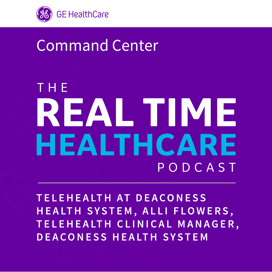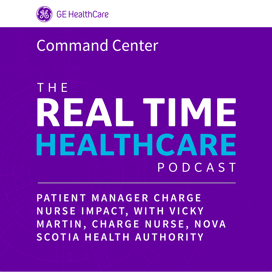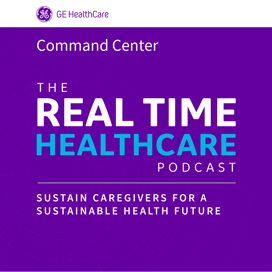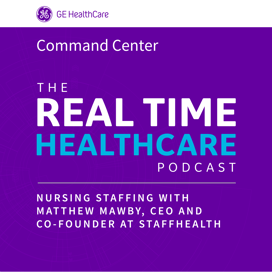#32 - Matthew Metsker, Director, Mission Control at Franciscan Health
Mar 24 · 20:28 min
In this Episode:
In this episode Jeff Terry is joined by Matt Metsker, who is the Division Director of mission control at Virginia Mason Franciscan Health. Recently, CHI Franciscan, now Virginia Mason Franciscan Health, published on the terrific results of the mission control program about 18 months in. Which improved 561 patients discharged sooner, 150 patients who got critical care expedited, and on down the line. Hear more about what went into getting those results.
Jeff Terry:
Hello and welcome. I'm Jeff Terry. Very happy to be joined today by Matt Metsker, who is the Division Director of mission control at Virginia Mason Franciscan Health. Hello, Matt.
Matt Metsker:
Good morning, Jeff. How are you doing?
Jeff Terry:
Terrific. Good morning. Recently, CHI Franciscan, now Virginia Mason Franciscan Health, published on the terrific results of the mission control program about 18 months in. *Which improved 561 patients discharged sooner, 150 patients who got critical care expedited, and on down the line.
We're here today with you, you really run the program, to get a layer below that so our audience can understand how do those big results really happen? So we'll try to unpack that. So my first question, I think I see some of it behind you on the white board, my first question is who are the sub-teams? What are the components of mission control?
Matt Metsker:
Right. Yeah. Those teams are really important and that's how the work gets done here. In reality, we have six teams here in mission control. We have the transfer center, which is made up of experienced RNs who are kind of facilitating all different types of transfers into the system, between hospitals in the system, inside out, and direct admissions.
We have the central patient placement team which does bed control. And we do that for all seven sites. We have a mix of RNs and non-RNs that are really kind of looking at the beds as a system resource rather than kind of each siloed hospital's bed, so that we can really maximize access and avoid loss cases.
We have the centralized staffing office. So we do the acute care nurse staffing and scheduling for all seven hospitals. Having that big picture, again, as far as nurse availability, call-out trends, and we also schedule and staff the CNAs at every site, is really important. When you have the beds, you need to have the nurse staffing too. Because a bed isn't really available for patient care unless it's staffed.
And we also have a unique role called the clinical expediter, which is an experienced RN, usually someone who's had time as a critical care nurse or a house supervisor, that is really looking to improve delays in care. And there's several ways that we kind of pick up on those delays in care. And so they're kind of searching regularly for the biggest bottleneck or the biggest constraint at one of our sites and helping move patients through that phase in their care.
We have the physician on duty program, which actually a really innovative program where we have physicians with FTEs in our organization come and work additional almost like per diem shifts for us. And they sit next to the transfer center, they collaborate with their colleagues to get patients accepted and transferred between different hospitals, to really stretch and see if we can keep cases inside our system that can be cared for safely here. To really hold folks accountable to their service line agreements. And to review cases and help triage which transfers should be highest on the priority level.
And then we actually have another role which doesn't directly report to me, but we have our ambulance coordinator here, EMS coordinator. We think it's a great resource to have co-located with us. They sit kind of between bed control and the transfer center. So if you can imagine, transfer center gets a call requesting a transfer. They collaborate, they talk with bed control instead of having to send a text or email. And the EMS coordinator is right in the middle of that. And so you get the request for the transfer, the availability of the bed, and the way to move the patient between those two spots all on one spot. No texts, no pagers, no faxes. You achieve synergies when you have all six of those teams in the same room.
Jeff Terry:
Absolutely. And of course, there's a central component of mission control. But I guess just worth noting for the audience, it's in service of the frontline teams and the frontline teams are very connected with this activity, with the information.
Matt Metsker:
Yeah, definitely. I would say specifically at three of our sites, we have satellite walls, which is kind of like a mini display of the wall of analytics. And usually those are in a prominent area that the house supervisors work in or other nursing leaders. And so they can kind of see, especially the throughput related tiles at the same time as that we can. Of course you can pull up the tiles on any workstation, but if it's up constantly on a big wall, it kind of gives you situational awareness at your site.
So yes, we interact every minute of every day with the charge nurses, house supervisors, occasionally nursing directors, definitely ED positions, all those folks that have to do with patient care delivery and patient logistics. We've actually built in some mechanisms as well so that when we assign a bed, for example, we have automatic pages that go out to the sending unit, the receiving unit, and the house supervisor to just kind of streamline communication. So I think that kind of speaks towards what mechanisms you need to have in place so that even if you have the right people and the right information, that you're on the same page as the sites that you're coordinating the care with.
Jeff Terry:
Absolutely. Well one of the things I love, I'd love you to come at this, one of the things I love about your mission control program is the interventions and the operating mechanisms. It's very active and proactive. So can you share some of that?
Matt Metsker:
Yeah, I would say one of the things that helps us create our interventions is that we have a regular meeting where we have multiple disciplines included in our health system. So we know we have the leaders of care management, nursing, diagnostic imaging, therapy, medical staff all in the same meeting so we can talk about if there's intervention.
So when we notice that a patient is experiencing a delay in care related to occupational therapy or ultrasound or something, then we know that who's responsible in mission control and who is responsible on the site. We have kind of a standard operating procedure for all those interventions.
If something is delayed, depending on modality, 12 hours, the clinical expediter has the first number they call the second number they call. We have actually built in different views into their electronic medical records to see if they can see the technician work list for like CT. So they can see how that CT tech is coordinating and prioritizing the care they have to deliver.
But they only have mostly the small picture. The clinical expert or mission control has the big picture of bottlenecks in the whole system. So we work with each service line, each department to come up with what are the appropriate interventions, who are the appropriate stakeholders, and we have to agree on those timelines. And in that meeting and then a subsequent meeting, a board meeting helps accountability for that whole group. So yeah, you really can't make the impact you want at the sites unless you form those good relationships and that clear pathway for intervention at each sites with each discipline.
Jeff Terry:
About how many interventions would you say are well-documented in that way or sort of fully defined?
Matt Metsker:
For every tile we have here, every alert has a person or a group assigned to it. As a primary owner, secondary owner, and then just a stakeholder. So we kind of assign all the pieces of information to different folks. Otherwise, why do we have that information? We track specific interventions for the clinical expediter and the physician on duty. And so we have an intervention tracker that we regularly examine. Do we have the right things? Are we tracking the right work? Is it having the impact we want? And that allows us also to put some operational methodology and some financial methodology around it too.
So if the physician on duty, for example, achieved 20 downgrades in December, downgrade of a ICU patient, getting to a PC or med tele level of care to free up that ICU bed. You can put some rigor around that share with your stakeholders. So we will look at loss case prevention, downgrades, mitigating a patient safety event, reducing boarding. Those are common things we look at for the physician on duty. For the clinical expediter, we might look at NPO alerts that were found. In other words, patient was approaching a surgery or procedure. They weren't made NPO. In other words, they could still be given a diet, which means they might miss that surgery or procedure. How many of those we prevented. How many diagnostic imaging or therapy delays that we were able to move up in the queue so the patient could discharge that day.
We actually look at observation to in-patient conversions as well. We kind of have broadened the expertise of our clinical expediters by working with our care management team and our physician advisor teams to help them notice when a patient may be appropriate for inpatient care instead of observation care. Because that clinical expediter actually sits right next to bed control.
So if you think about it, you get a bed request to bed control for observation status, but then the patient maybe is boarding for a little while, they decompensate. Now they're on bi-pap or they're getting fed or something. And the clinical expediter knows that, hey that's not an observation patient anymore, that patient's really sick. They've got sepsis or respiratory failure or whatever. Give them the training maybe with MCG criteria or Qualcomm or InterQual I should say. And they can get an inpatient conversion. So get that patient in the appropriate status earlier, even though they're not in the care management team, because they're right there next to where the care is being delivered.
Jeff Terry:
That's brilliant. And so many examples, it's wonderful to hear them. You've mentioned tiles a few times. Do you mind sharing the tiles that you have in use? Of course, for our audience, the tiles are the real time apps in the command center software.
Matt Metsker:
Yeah. Yeah we have the capacity snapshot tile related to bed availability across the system. The borders tile showing patients trying to get into the system from all different angles. A care progression, which is related to delays in care. Observation management specifically for observation patients. The transfer tile. The discharge planning tile and discharge escalation, which are kind of two phases of one tile. The census forecast tile, which has to do with predicting for census in the future. The infectious disease tile, which we have tailored to be tracking COVID positive patients, currently.
The advanced illness and risk of dying tile, which is a great tile related to our patients who are deteriorating or are palliative care or hospice candidates. And the post acute placement tile. And the last tile we will get is our surgical and procedural grow tile. So that'll be our 11th. And that would be the full complement of this initial phase.
Jeff Terry:
I'd love, if you don't mind, now for you to maybe take our audience around the mission control.
Matt Metsker:
Yeah. Let me see. I'll get mobile here. I'm going to take a tour down through the bullpen here. You can see kind of the space. We have this whole side is just all window so that we get some natural light in here because folks are obviously looking at screens a lot. If you walk through here we have bed placement over on this side. Our clinical expediter. We have an ambulance coordinator. Have the transfer center over here. And then we have our wall of analytics up here at the front. 18 screens. Every tile that we have actually so far up here.
Jeff Terry:
Our audience, of course, the tiles are useful to be viewed on the wall for that constant situation. They're web apps, so they can be viewed anywhere. Yeah. But it'd be great if you could kind of go down the wall and give a little thumbnail on each of them.
Matt Metsker:
Sure. Yeah. So this first tile up here, this is the capacity snapshot tile. You can kind of see right here. It has a bed availability for every hospital by level of care. And you can also sort it by any kind of specialty bed. So a dialysis bed or the bariatric bed, negative air pressure. So we can kind of look at every site, every level of care and then filter it by the specific type of bed we need. It also shows us what beds are available now based on discharge orders and our electronic medical record. And what beds will open up once all the net moves are made.
So it kind of lets you see you at a glance for our seven hospital system, how many ICU beds you have in total, how many of those are negative air pressure. You can look by level of care for any of that information. It helps you be able to accept patients and transfer easier than if you had to go through a different bed board in your electronic medical record per site.
Jeff Terry:
Brilliant.
Matt Metsker:
This right there, this next tile is the borders tile. This kind of shows us where patients are waiting to get into the system from the various areas. So patients from the ED, from PACU, from procedural areas, and internal transfers. So it helps us prioritize the different inflows into our hospital and balance those. It's easy to potentially give preference to patients coming from the OR through the PACU, but you don't want those ED patients stacking up, reducing your ability to care for patients in the ED. So they have to find an equitable way. We have a patient prioritization matrix that we agreed upon here as a system to help us get patients in from all areas.
Next here we have our observation tile. This is specifically related to our observation patients. As you know, every hospital has them, but not every hospital has a discrete unit for observation patients. Usually, you have more OBS patients than you have OBS beds. And so if those are mixed throughout the hospital, then you know the patient care team may not actually know that that is an observation patient.
Now probably your care manager knows, probably the hospitalist knows, or the medical staff. But therapy, diagnostic imaging lab, all this folks might not know. So if you create this virtual observation unit, then everyone can start prioritizing patients differently. And that's really how you will reduce the length of stay by having everyone know this is an OBS patient. So if you have a routine order for physical therapy for an inpatient and an OBS patient, who should get that care first? The OBS patient because they're supposed to have a shorter length of stay. So this tile helps us manage those delays and set the expectation that this is an OBS patient, their care should look different.
Next here we have the care progression tile. It actually shows us delays in care related to imaging procedures or surgeries and services.
So imaging could be any diagnostic imaging related modality, he procedure being done, or the read of it from the radiologist. Because both of those things can be a delay for the care team. The procedural section shows us patients who are delayed waiting for a procedure like a scope or an interventional radiology procedure, or the fact that maybe they haven't been made NPO, but they're approaching that procedure so they could miss it.
The service delay has to do with therapy, physician console, all those things that you want to have eyes on. If your patients on average wait a long time when they have a cardiology consult, if you knew that, you could build an interventions that would shorten that length of stay, get that patient through their hospital stay.
Jeff Terry:
Absolutely.
Matt Metsker:
Next this purple tile here is our census forecast tile. This includes machine learning so that it helps us look at what the census is looking like 24, 48 hours, seven days in advance. Helps you match your staffing and it gives you the opportunity to schedule differently potentially too. The idea is that it improves an accuracy over time because it has a machine learning component in it. And we're kind of still learning how to best utilize that as a system. But it's exciting information for us to have.
We have the discharge escalation tile. That's the view we show in the mission control. At the sites, they use the discharge planning tile, which is actually a visual tool used in rounding. So the care teams pull it up during rounds. It shows the GMLOS so that you know how your patient is tracking and their length of stay related to what their DRG says they should be tracking for. It also allows you to put in barriers in real time and assign those to folks so that you actually get forward movement rather than everyone kind of knowing that this patient is waiting for something, but not having a visual cue for everyone, or being able to assign that.
This purple tile down here is the advanced illness and risk of dying tile. It's a pretty exciting one, in my opinion. It touches the clinical pieces pretty well. It has a deterioration score in it. So patients with a certain score like score over 60, for example, are at higher risk for deterioration or even mortality in the hospital.
So we can take a look at those, train the code teams at each hospital to review that. We can also see patients who have had palliative care or hospice consult over previous patients of palliative care and hospice. So that if they're in the hospital, maybe they're dealing with multiple chronic conditions or an end-stage condition. And they've been a palliative care patient before, but that consult hasn't been ordered in the hospital. Someone can take a look at that and say, you know what? We really should bring them in, make sure we have the goals of care right, and get them to the appropriate care setting.
This right here is our transfer tile. And it actually comes with a map view as well, which I really like. Because we have a large geographic region. But this transfer tile is really broken into four sections. Internal transfers within our system. We have external transfers into our system from outside. Internal transfers to externals points and then direct admissions from physician offices. So those are the full compliment of tiles we have up now. Like I mentioned earlier, we'll have the surgical and procedural growth tile next. And we'll make some space on here for it. Maybe we'll lose the map, I guess. And this is kind of the bullpen with the different folks utilizing this wall.
Jeff Terry:
That's brilliant. And do you have a favorite tile of those, Matt?
Matt Metsker:
You know what?
Jeff Terry:
One you're in most often?
Matt Metsker:
Yeah. I would say what's often asked of me is to help set priorities for what the system should do next. So we have regular operating meetings related to our COVID capacity issues. And so if I look at borders, cap snap, and transfers, I can tell you probably in about 30 seconds what the state of our entire 1,300 bed system is. And where our tensions are likely focused.
If I would tell you what tiles kind of the funnest to play around in for me, it's the advanced illness and risk of dying tile. I still see patients. I'm a PA by training. And for me to know which of my patients is at risk for deterioration, which have had involvement from palliative care and hospice in the past, are they in a safe care setting? I really enjoy looking at that tile. See there's a lot of opportunity there for clinicians, so.
Jeff Terry:
Brilliant. Matt, that's wonderful. Well, maybe I'll... Thank you. I'll get you out, one last question, which is so we're finishing the procedural growth tile. That's exciting. Which would help us manage the next couple of weeks of our procedural surgical volume. What's your vision for where this all goes next? What excites you when you look 12 or 18 months out?
Matt Metsker:
Yeah. I would say optimization is a really exciting point for me. We're about 18 months in, I think, as we mentioned. And it's been a cultural change, not just having a new department, but it's been a cultural change for the system. So I think really the appetite for this work is really growing across the system at all the sites. Whereas before, we had to really work to garner the initial interest. Now people are reaching out to us. We want more training. We want retraining. I think we could spend weeks on each tile to optimize the impact we have at each site. So I'm excited to work with the teams now that the appetite is growing. I think this has been an invaluable asset during COVID.
I think as far as potential next focuses for the department and the tiles that we choose, it could be related to more choreographing care, having some disease where we're pretty certain on the regular progression through that hospitalization and getting that more to where a patient can expect what's next. Who are the players involved? I have this procedure, I have this diagnostic, I have this lab and these are my milestones. So I think there's opportunity to give that to the patients, more of a roadmap. So the care team can kind of navigate that with them.
Jeff Terry:
That's brilliant. Matt, congratulations on the success. A great tour. It looks great behind you, by the way. That's a really cool shot there.
Matt Metsker:
Thanks.
Jeff Terry:
It's been our great pleasure to work with you and for you. Thank you for letting us serve you. Congratulations. And I hope it continues a long time.
Matt Metsker:
Thanks so much, Jeff, talk to you soon.
Jeff Terry:
Yes, sir. And with that, we'll close the podcast.







